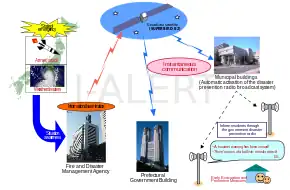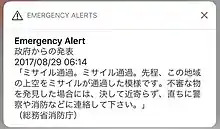
J-Alert (Japanese: J-ALERT/Jアラート, romanized: J Arāto; full name 全国瞬時警報システム, Zenkoku Shunji Keihō Shisutemu, 'National Early Warning System') is the early warning system used in Japan. J-Alert was launched in February 2007.[1] The system is designed to quickly inform the public of threats and emergencies such as earthquakes, severe weather, and other dangers. The system was developed in the hope that early warnings would speed up evacuation times and help coordinate emergency response.[2]
System
J-Alert is a satellite based system that allows authorities to quickly broadcast alerts to local media and to citizens directly via a system of nationwide loudspeakers, television, radio, email, and cell broadcasts.[3] According to Japanese officials, it takes about one second to inform local officials, and between four and twenty seconds to relay the message to citizens. An enhanced version of the J-Alert receivers were installed by the end of March 2019. The new models can automatically process the information within two seconds, compared to the older models that can take up to twenty seconds.[4]
J-Alert broadcasts via both ground systems and the Superbird-B3 communication satellite.[5]
When there is a civil emergency such as a ballistic missile heading towards Japan, a special air raid siren sounds across loudspeakers and on TV and radio.
Information transmission capabilities

- Earthquake
- Earthquake Early Warning
- Quick updates on hypocenter, magnitude, and precautions of possible tsunami
- Information of hypocenter, magnitude, intensities of various areas, and the presence of tsunami
- Earthquake prediction warning for the Tōkai earthquakes
- Earthquake prediction advisory information of the Tōkai earthquakes
- Earthquake prediction information of the Tōkai earthquakes
- Tsunami
- Volcano eruption
- Emergency warning of volcanic eruption and the possibility of eruption
- Warning of volcanic eruption and the possibility of eruption
- Volcanic crater forecast
- Severe weather
- Emergency warnings for heavy rain, heavy snow, gale, snowstorm, waves, and storm surge
- Warnings for heavy rain, heavy snow, gale, snowstorm, waves, and storm surge
- Weather advisory
- Information of the risk of landslides
- Advisory information for tornado
- Information of violent heavy rain
- Flood forecast
- Special emergency threats
- Information of ballistic missiles
- Information of airstrikes
- Information of guerrilla and special forces attacks
- Information of large-scale terrorism
- Other information for civil and national defense[3]
Adoption rate
Many prefectures and urban areas were slow in adopting the system. Upon its introduction, the Japanese government hoped to have 80% of the country equipped with the J-Alert system by 2009.[2] However, by 2011, only 36% of the nation had been covered. Cost had been a major factor; the initial installation is estimated to be around 430 million yen, and the yearly maintenance is estimated to be around 10 million yen.
By May 2013, 99.6% of municipalities nationwide were covered.[6]
Notable instances
- On 13 April 2023 a North Korean missile launch warning led residents to take cover from debris that most likely fell into the sea hundreds of miles away. The alert, just before 8 a.m., triggered sirens on Hokkaido and sent automated messages to mobile phones in a system called J-Alert urging the northern island's more than five million residents to seek immediate shelter, after Pyongyang fired a new type of ballistic missile.[7]
See also
References
- ↑ "J-Alert: disaster warning technology in Japan – Centre for Public Impact". CentreForPublicImpact.org. Retrieved 29 August 2017.
- 1 2 "Japan Launches Alert System For Tsunamis And Missiles". Retrieved 29 August 2017.
- 1 2 "Jアラートの概要" (PDF). Archived from the original (PDF) on 18 September 2017. Retrieved 29 August 2017.
- ↑ "Disaster agency urges municipalities to upgrade J-Alert receivers". The Japan Times Online. 7 August 2017. Retrieved 29 August 2017.
- ↑ "東京都地域防災計画" [Tokyo Metropolitan Area Disaster Prevention Plan] (PDF). 東京都防災 (Tokyo Disaster Prevention Information) (in Japanese). 17 April 2021. Retrieved 17 April 2021.
- ↑ Torres, Ida (31 October 2013). "J-alert to serve as early warning system during weather emergencies". The Japan Daily Press. Archived from the original on 29 August 2017. Retrieved 29 August 2017.
- ↑ Kelly, Tim (13 April 2023). "Japan stands by cancelled missile alert sent to millions of residents". Reuters. Retrieved 11 July 2023.
External links
- J-Alert Overview Fire and Disaster Management Agency, Ministry of Internal Affairs and Communications
- 国民保護室・国民保護運用室 Archived 1 September 2017 at the Wayback Machine Fire and Disaster Management Agency, Ministry of Internal Affairs and Communications
- 北朝鮮から発射された弾道ミサイルが日本に飛来する可能性がある場合における全国瞬時警報システム(Jアラート)による情報伝達について Cabinet Secretariat Civil Protection
- 全国瞬時警報システム(J-ALERT)の整備 Ministry of Internal Affairs and Communications
- Guide on disaster prevention and mitigation effort during earthquakes and tsunamis Japan Meteorological Agency
- Protecting guide against Armed Attacks or Terrorism Cabinet Secretariat Civil Protection
- J-Alert message relayed during the 2011 Tōhoku earthquake, warning of an imminent tsunami
- 全国瞬時警報システム 実際の放送例 (J-Alert Demonstration) YouTube